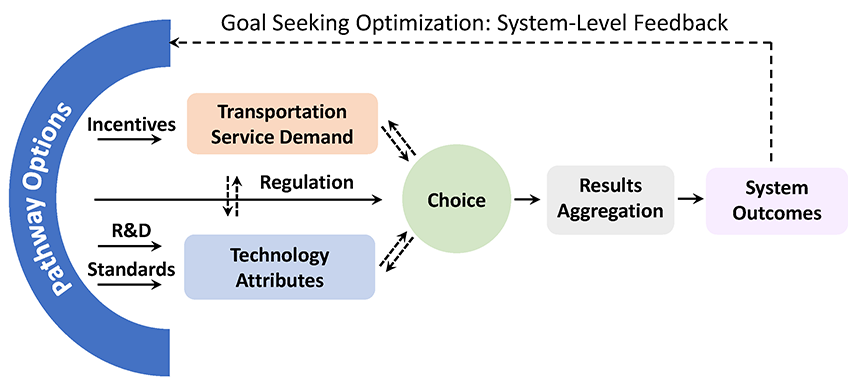TEMPO: Transportation Energy & Mobility Pathway Options Model
The Transportation Energy & Mobility Pathway Options (TEMPO™) model is a comprehensive transportation demand model that covers the entire United States.
Researchers use the TEMPO model to explore pathway options for developing long-term scenarios that support strategic transportation and energy objectives and to assess synergies with energy supply.
TEMPO characterizes opportunities for current and emerging fuels, technologies, and business models across transportation sub-sectors and segments, taking into account:
- Dynamic passenger and freight demand
- Technology adoption and vehicle ownership decisions
- Mode choice
- Fueling infrastructure
- Heterogenous multi-day mobility
- Travel requirements across different consumer segments.
In addition to capturing mobility details across various consumers and applications, TEMPO's implicit hourly temporal resolution enables the generation of time-resolved energy use profiles to assess aspects of multisectoral integration.

Illustration of the TEMPO model framework
Current and anticipated changes in transportation technologies, mode choices, and business models—such as those introduced by ride-hailing services, micro-mobility, and vehicle electrification—are reshaping transportation energy demand. TEMPO addresses gaps in traditional modeling frameworks to generate scenarios for future transportation energy use and integration with other energy systems.
To address these gaps, TEMPO provides:
- Modeling of emerging trends and novel possibilities, including ownership and business models, alternative fuel vehicles, and connected and automated vehicles
- Characterization of choice to account for variation among decision-makers and their decision contexts (e.g., household-level choice for personal travel)
- Sufficient spatiotemporal resolution to reflect how different choices affect system-level interactions
- Cross-sector integration, particularly supply/demand integration with the electricity sector.
To learn why TEMPO matters, read this article: Future Integrated Mobility-Energy Systems: A Modeling Perspective.
TEMPO improves understanding of:
- The potential for radical changes in transportation demand and related impacts on energy use
- Pathways to improve efficiency in the transportation sector across all travel modes and fuel types
- Opportunities to expand the use of different transportation technologies and fuels across market segments and consumer groups
- Interconnections with other sectors and infrastructure, particularly the electric power system.
Key Features and Capabilities
The TEMPO model includes these key features and capabilities:
- Explores external disruptions and "what-if?" scenarios
- Performs endogenous out-of-sample analysis, extrapolating emerging trends and capturing impacts of technological advances, socioeconomic factors, and behavioral changes (e.g., impact of transportation network companies on transportation demand)
- Generates time-resolved (hourly) energy use profiles based on individual trips, enabling interconnections with power grid models (bulk and distribution) including, for example, the ability to represent demand response and "smart" electric vehicle charging behavior that aligns with mobility needs
- Provides household-level travel demand, vehicle ownership, and mode/technology choices based on varied consumer preferences, accounting for socio-demographics (income, household composition), technology attributes (cost, travel time, comfort, safety), geography (urban, secondary cities, rural), and population-specific multi-day mobility and travel requirements
- Includes enhanced mode/technology choice modeling among transportation options based on cost, travel time, and other factors (comfort, safety) to assess potential mode shifts in passenger and freight movement
- Accounts for diverse technology attributes and characteristics of consumers, households, and firms to estimate market segments and assess market potential for current and emerging technologies and business models
- Represents the role of fueling infrastructure in supporting and advancing alternative fuel use
- Incorporates non-linear trends, dynamics, and complex feedback loops that enable, reinforce, or limit technology adoption.
TEMPO Documentation
To learn how TEMPO works (validation), refer to Exploring the Future Energy-Mobility Nexus: The Transportation Energy & Mobility Pathway Options (TEMPO) Model, Transportation Research Part D (2021).
For an overview of the TEMPO model, refer to The Transportation Energy and Mobility Pathway Options (TEMPO) Model – Overview and Validation of Version 1.0, NLR Presentation (2021).
Publications
Assessing Total Cost of Driving Competitiveness of Zero-Emission Trucks, iScience (2024)
Highly Resolved Projections of Passenger Electric Vehicle Charging Loads for the Contiguous United States, NLR Technical Report (2023)
Electric Vehicle Managed Charging: Forward-Looking Estimates of Bulk Power System Value, NLR Technical Report (2022)
Exploring the Future of Mobility: Transportation Energy and Mobility Pathway Options Model, NLR Fact Sheet (2020)
Contact
Share
Last Updated Dec. 24, 2025
